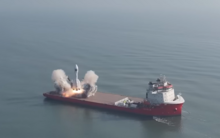
A floating launch vehicle operations platform is a marine vessel used for launch or landing operations of an orbital launch vehicle by a launch service provider: putting satellites into orbit around Earth or another celestial body, or recovering first-stage boosters from orbital-class flights by making a propulsive landing on the platform.
In the early decades of spaceflight technology, all orbital launch vehicle operations were exclusively from land, and all booster stages were expended after a single use for nearly 60 years after the first orbital spaceflight, Sputnik 1. After the late 1990s and into the 2010s, new marine options for launch were built. Landing of orbital-class boosters began to be accomplished in 2015. More platforms, both for launch and landing, are currently in construction or planned.
Suborbital rockets and ballistic missiles had been launched from marine platforms earlier than the 1990s, but are not the topic of this article.